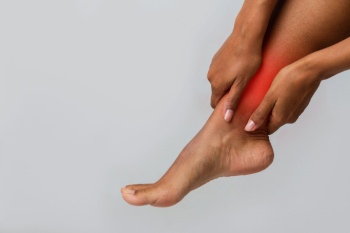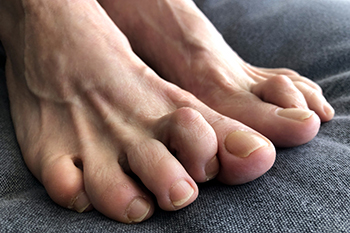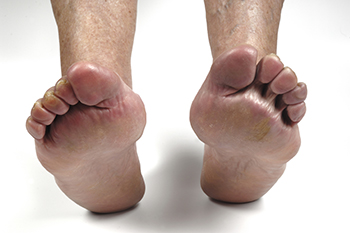
Cedarhurst (516) 374-3668
Franklin Square (516) 775-8440

Cedarhurst (516) 374-3668
Franklin Square (516) 775-8440

Foot problems are a common complication of diabetes, primarily stemming from a loss of protective sensation, or LOPS, and peripheral artery disease, or PAD. The loss of feeling in the feet results from nerve damage, which can make a patient unaware of injuries. Undetected blisters or sores increase the risk of infections and complications, and may lead to ulcers. Regular foot examinations by a podiatrist are essential for a diabetic experiencing either LOPS or PAD. Prevention strategies include wearing well-fitting shoes, checking for foreign objects in shoes, and being cautious of extreme temperatures. It is important to note that peripheral artery disease decreases blood flow to the feet, which results in pain, slow wound healing, and an elevated risk of foot ulcers and amputation. A podiatrist can assess blood flow to the feet to detect PAD early, which allows for prompt management. If you are diabetic and experience numbness and slow-healing wounds, it is suggested that you make regular visits to a podiatrist.
Diabetic foot care is important in preventing foot ailments such as ulcers. If you are suffering from diabetes or have any other concerns about your feet, contact Robert Stein, DPM from South Shore Foot Care. Our doctor can provide the care you need to keep you pain-free and on your feet.
Diabetic Foot Care
Diabetes affects millions of people every year. The condition can damage blood vessels in many parts of the body, especially the feet. Because of this, taking care of your feet is essential if you have diabetes, and having a podiatrist help monitor your foot health is highly recommended.
The Importance of Caring for Your Feet
Patients with diabetes should have their doctor monitor their blood levels, as blood sugar levels play such a huge role in diabetic care. Monitoring these levels on a regular basis is highly advised.
It is always best to inform your healthcare professional of any concerns you may have regarding your feet, especially for diabetic patients. Early treatment and routine foot examinations are keys to maintaining proper health, especially because severe complications can arise if proper treatment is not applied.
If you have any questions please feel free to contact our offices located in Cedarhurst and Franklin Square, NY . We offer the newest diagnostic and treatment technologies for all your foot and ankle needs.

Ankle pain can stem from various underlying factors, impacting mobility and daily activities. The ankle joint, comprising bones, ligaments, tendons, and muscles, facilitates essential movements like walking, running, and jumping. When this complex structure experiences stress, injury, or inflammation, it can result in discomfort and restricted movement. Common causes of ankle pain include sprains, caused by sudden twists or impacts that overstress the ligaments, and strains, which involve the stretching or tearing of muscles or tendons surrounding the ankle joint. Additionally, conditions such as arthritis, tendonitis, and fractures can contribute to persistent ankle pain, necessitating medical attention and intervention. Poor footwear choices, overuse during physical activities, and underlying health conditions can also make ankle discomfort worse. If you have ankle pain, it is suggested that you schedule an appointment with a podiatrist who can determine what the cause is and offer appropriate treatment methods.
Ankle pain can have many different causes and the pain may potentially be serious. If you have ankle pain, consult with Robert Stein, DPM from South Shore Foot Care. Our doctor will assess your condition and provide you with quality foot and ankle treatment.
Ankle pain is any condition that causes pain in the ankle. Due to the fact that the ankle consists of tendons, muscles, bones, and ligaments, ankle pain can come from a number of different conditions.
Causes
The most common causes of ankle pain include:
Symptoms
Symptoms of ankle injury vary based upon the condition. Pain may include general pain and discomfort, swelling, aching, redness, bruising, burning or stabbing sensations, and/or loss of sensation.
Diagnosis
Due to the wide variety of potential causes of ankle pain, podiatrists will utilize a number of different methods to properly diagnose ankle pain. This can include asking for personal and family medical histories and of any recent injuries. Further diagnosis may include sensation tests, a physical examination, and potentially x-rays or other imaging tests.
Treatment
Just as the range of causes varies widely, so do treatments. Some more common treatments are rest, ice packs, keeping pressure off the foot, orthotics and braces, medication for inflammation and pain, and surgery.
If you have any questions, please feel free to contact our offices located in Cedarhurst and Franklin Square, NY . We offer the newest diagnostic and treatment technologies for all your foot care needs.

Hammertoe, a deformity characterized by curled or flexed toes, may necessitate surgical intervention when conservative treatments fail to provide relief. Surgical hammertoe options include bone resection to remove portions of toe bones, tendon procedures involving manipulation or transplantation to correct the imbalance, and joint fusion to stabilize the toe. Following surgery, pins or wires may be used temporarily to maintain alignment during healing, with patients transitioning to supportive footwear to aid recovery. Surgical considerations are driven by functional impairment and pain, with persistent symptoms such as pain, irritation, and skin complications warranting consideration for intervention. However, surgery may not be recommended if conservative measures suffice or if the risks outweigh the benefits. It is important to explore all treatment plans before deciding on whether to have surgery. For this reason, if you have a hammertoe that is impeding your daily activities, it is suggested that you schedule an appointment with a podiatrist.
Hammertoes can be a painful condition to live with. For more information, contact Robert Stein, DPM of South Shore Foot Care. Our doctor will answer any of your foot- and ankle-related questions.
Hammertoe
Hammertoe is a foot deformity that occurs due to an imbalance in the muscles, tendons, or ligaments that normally hold the toe straight. It can be caused by the type of shoes you wear, your foot structure, trauma, and certain disease processes.
Symptoms
Risk Factors
Treatment
If you have hammertoe, you should change into a more comfortable shoe that provides enough room for your toes. Exercises such as picking up marbles may strengthen and stretch your toe muscles. Nevertheless, it is important to seek assistance from a podiatrist in order to determine the severity of your hammertoe and see which treatment option will work best for you.
If you have any questions, please feel free to contact our offices located in Cedarhurst and Franklin Square, NY . We offer the newest diagnostic and treatment technologies for all your foot care needs.

Rheumatoid arthritis, or RA, is an autoimmune disorder that has a profound effect on various joints, and the feet are not exempt from its reach. The chronic inflammation triggered by RA can lead to debilitating consequences for the feet, impacting their structure and function. The joints in the feet can become swollen, tender, and painful, making even simple movements a challenge. Over time, RA may cause deformities, such as bunions and hammertoes, altering the alignment of the feet. The condition also targets the synovium, a membrane surrounding joints, leading to the development of nodules. These nodules can form in the feet, further complicating already compromised mobility. Individuals grappling with RA often find themselves contending with stiffness and reduced range of motion in their feet, significantly affecting their quality of life. If you have foot pain that may be linked to RA, it is strongly suggested that you be under the care of a podiatrist who can determine what the best relief and management options are for you.
Because RA affects more than just your joints, including the joints in your feet and ankles, it is important to seek early diagnosis from your podiatrist if you feel like the pain in your feet might be caused by RA. For more information, contact Robert Stein, DPM of South Shore Foot Care. Our doctor will assist you with all of your podiatric concerns.
What Is Rheumatoid Arthritis?
Rheumatoid Arthritis (RA) is an autoimmune disorder in which the body’s own immune system attacks the membranes surrounding the joints. Inflammation of the lining and eventually the destruction of the joint’s cartilage and bone occur, causing severe pain and immobility.
Rheumatoid Arthritis of the Feet
Although RA usually attacks multiple bones and joints throughout the entire body, almost 90 percent of cases result in pain in the foot or ankle area.
Symptoms
Diagnosis
Quick diagnosis of RA in the feet is important so that the podiatrist can treat the area effectively. Your doctor will ask you about your medical history, occupation, and lifestyle to determine the origin of the condition. Rheumatoid Factor tests help to determine if someone is affected by the disease.
If you have any questions please feel free to contact our offices located in Cedarhurst and Franklin Square, NY . We offer the newest diagnostic and treatment technologies for all your foot and ankle needs.
Every patient is unique and so are treatments. The information on this website is for educational purposes and each individual
patient care model may differ.